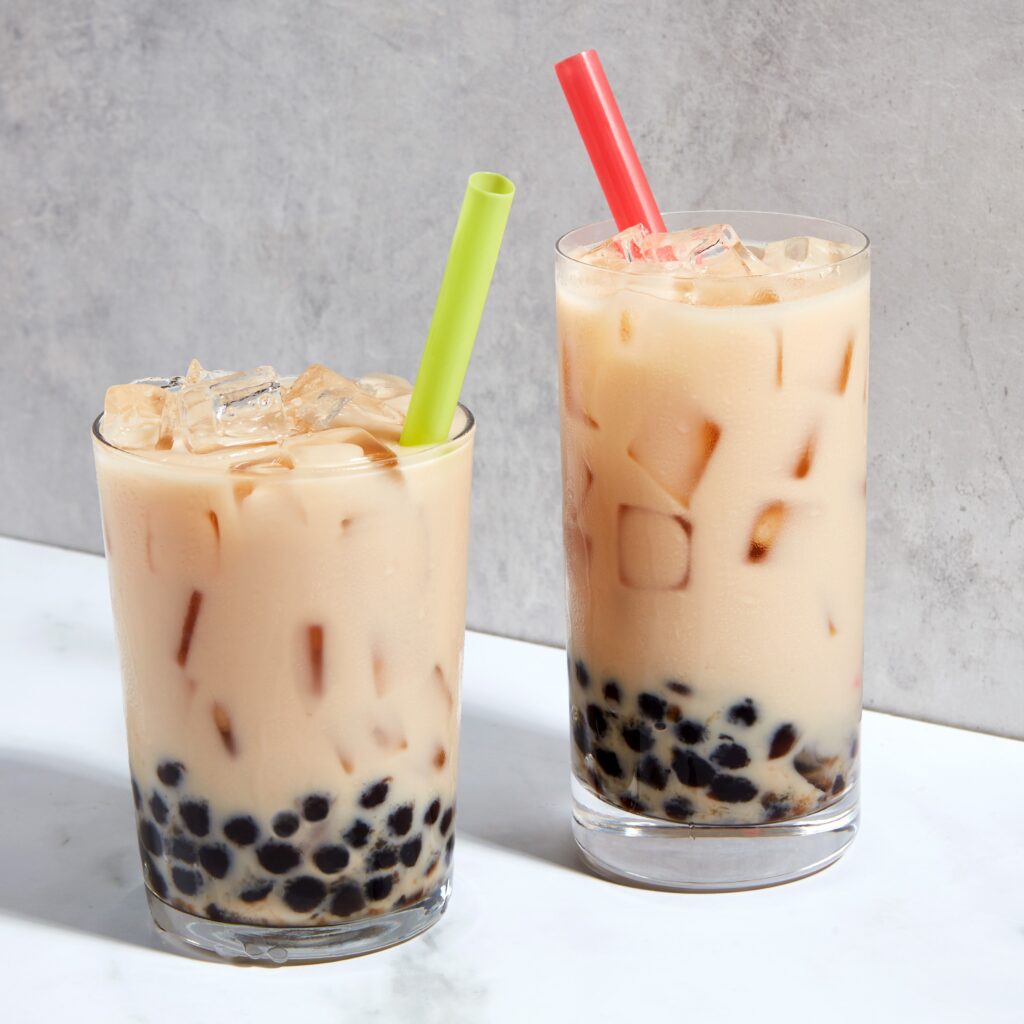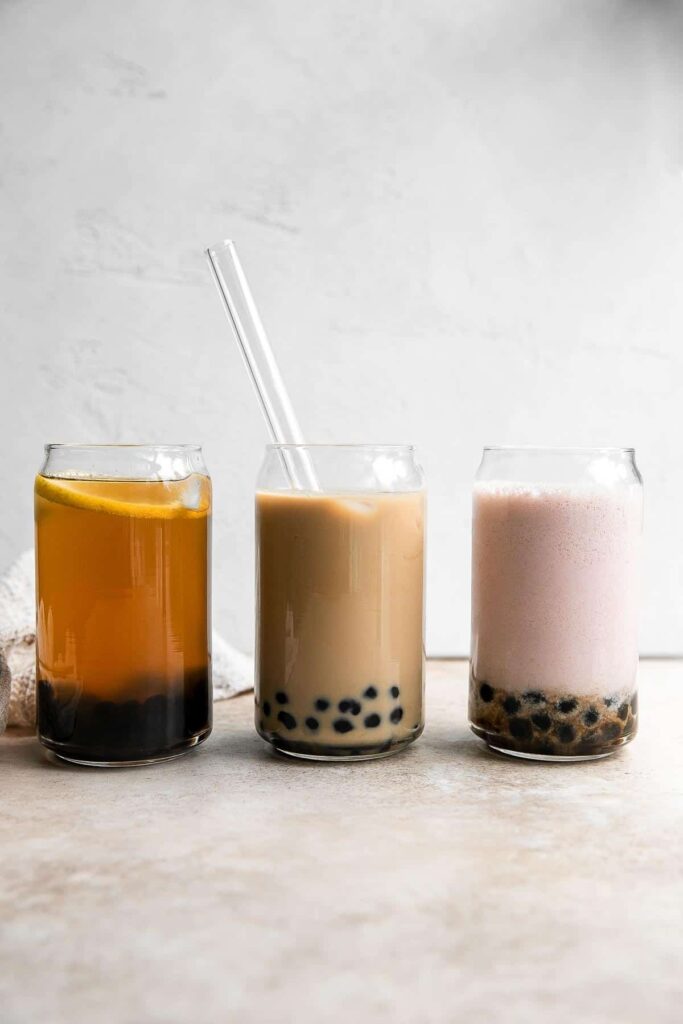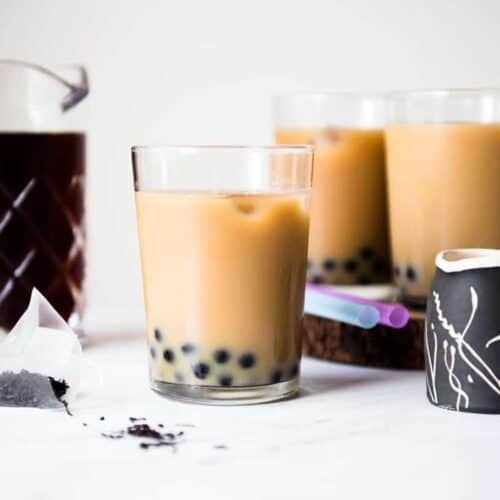How to Make Delicious Milk Tea at Home
Are you a fan of milk tea? Do you often find yourself craving that perfect blend of tea and milk, but don’t want to venture out to a cafe every time? Well, we have good news for you! In this article, you will discover the secrets to making delicious milk tea right in the comfort of your own home. Whether you prefer a classic black milk tea or a trendy flavored one, we’ve got you covered. Get ready to elevate your tea-drinking experience with these simple yet effective tips and techniques. So grab your tea leaves, milk, and favorite sweetener, because it’s time to create the perfect cup of homemade milk tea.

Choosing the Tea
Selecting the Base Tea Leaves
When making milk tea, the first step is to choose the perfect base tea leaves. There are various options to consider, such as black tea, green tea, oolong tea, or even herbal tea. Each type of tea will give a unique flavor profile to your milk tea. If you prefer a stronger and bolder taste, black tea is a great choice. On the other hand, green tea offers a lighter and more delicate flavor. Oolong tea falls in between, providing a balance of robustness and subtlety. Herbal tea can add a delightful twist with its naturally fragrant and soothing properties. Consider your personal preference and how the base tea will complement the other ingredients in your milk tea.
Considering Flavored or Blended Tea
Once you have decided on the base tea leaves, you can explore flavored or blended tea options to enhance the taste of your milk tea. Flavored teas come in a wide range of options such as jasmine, earl grey, or fruit-infused teas. These teas have been infused with natural flavors and can add a delightful twist to your milk tea. On the other hand, blended teas combine different types of tea leaves, creating a unique flavor profile. For example, a blend of black tea and green tea can offer a balance of boldness and freshness. Experiment with different flavor combinations and find the one that suits your taste buds the best.
Choosing Loose Leaf or Tea Bags
Another decision you need to make is whether to use loose leaf tea or tea bags. Both options have their own advantages. Loose leaf tea allows for more control over the flavor and strength of your milk tea. It also provides a more authentic and traditional tea-drinking experience. Tea bags, on the other hand, offer convenience and ease of use. They are pre-measured and ready to brew. If you are short on time or prefer a hassle-free process, tea bags can be a great option. Ultimately, the choice between loose leaf tea and tea bags depends on your personal preference and the experience you want to create while making milk tea.
Preparing the Tea
Measuring the Tea Leaves
To ensure a perfect balance of flavor in your milk tea, it is important to measure the tea leaves correctly. The ideal ratio is typically one teaspoon of tea leaves per cup of water. However, this can vary depending on personal preference and the strength of the tea leaves. If you prefer a stronger flavor, you can add more tea leaves, whereas if you prefer a milder taste, fewer tea leaves can be used. Experiment with different measurements to find the perfect ratio that suits your taste buds.
Boiling the Water
The temperature of the water plays a crucial role in the brewing process of milk tea. For black tea and herbal tea, boiling water is recommended to release the full flavor of the tea leaves. On the other hand, green tea and oolong tea require slightly lower temperatures to prevent bitterness. It is recommended to bring the water to a boil and let it cool for a minute or two before pouring it over the tea leaves. This will give you the right balance of flavor without overpowering the delicate notes of green tea or oolong tea.
Steeping the Tea Leaves
Steeping the tea leaves is the process of infusing them in hot water to extract their flavors. Depending on the type of tea you are using, the steeping time will vary. Black tea usually requires 3-5 minutes, while green tea and oolong tea need around 2-3 minutes. It is important to follow the recommended steeping time to avoid bitterness or a weak flavor. Use a timer to monitor the steeping process and achieve the desired flavor profile. Once the tea leaves have steeped, it’s time to move on to the next step of making milk tea.
Adding Sweetener
Deciding on the Sweetener
Adding sweetener to your milk tea can enhance the overall taste and provide a pleasant balance of flavors. There are various options for sweeteners, including sugar, honey, agave syrup, or even condensed milk. Sugar is the most common choice and can be added according to personal preference. Honey and agave syrup offer a natural sweetness and can be a healthier alternative. If you prefer a creamier and richer taste, condensed milk can be a delicious option. Consider your dietary needs and taste preferences when choosing the sweetener for your milk tea.
Measuring the Sweetener
To maintain consistency in the sweetness level of your milk tea, it’s important to measure the sweetener accurately. Start with a small amount and gradually increase until you achieve the desired level of sweetness. It’s easier to add more sweetener if needed than to dilute an overly sweetened milk tea. Generally, one to two teaspoons of sugar or honey per cup of milk tea is a good starting point. Adjust the amount based on your personal taste preference.
Stirring to Dissolve the Sweetener
Once you have added the sweetener to your milk tea, it’s crucial to stir it well to ensure proper dissolution. Use a spoon or stirrer to gently mix the sweetener into the tea, making sure it is evenly distributed. This will help in achieving a consistent flavor throughout the drink. Take your time and stir until the sweetener is fully dissolved before moving on to the next step of incorporating milk into your milk tea.
Incorporating Milk
Selecting the Type of Milk
Choosing the type of milk is a crucial step in making milk tea. The type of milk you use will greatly impact the taste and texture of your drink. The most commonly used milk options for milk tea are regular dairy milk, almond milk, soy milk, and oat milk. Regular dairy milk provides a creamy and rich taste, while almond milk adds a nutty flavor. Soy milk offers a slightly sweeter taste and a smooth texture. Oat milk provides a more subtle flavor and a creamy consistency. Consider any dietary restrictions or preferences before selecting the type of milk for your milk tea.
Determining the Milk-to-Tea Ratio
The milk-to-tea ratio determines the creaminess and overall balance of your milk tea. The general rule of thumb is to use a 1:1 ratio of milk to tea. However, this can vary depending on personal preference. If you prefer a stronger tea flavor with just a hint of milkiness, you can decrease the amount of milk. On the other hand, if you prefer a creamier and more indulgent milk tea, you can increase the milk proportion. Experiment with different ratios until you find the perfect balance that suits your taste buds.
Heating the Milk
Before incorporating the milk into your milk tea, you need to heat it. Heating the milk will not only blend it seamlessly with the tea but also enhance the overall flavor and aroma. Use a small saucepan or pot to heat the milk over medium heat. It’s important to stir the milk occasionally to prevent scorching or forming a skin on top. Once the milk is heated to your desired temperature, remove it from the heat and proceed to the next step of enhancing the flavor of your milk tea.

Enhancing the Flavor
Adding Spices or Flavorings
To take your milk tea to the next level, consider adding spices or flavorings. Spices like cinnamon, cardamom, or nutmeg can provide a warm and aromatic touch to your milk tea. Simply sprinkle a pinch of the desired spice into the tea while it is steeping or add it to the milk while heating. Additionally, you can experiment with flavorings such as vanilla extract, almond extract, or even lavender syrup. These flavorings can add a unique twist and elevate the taste profile of your milk tea. Start with small amounts and adjust according to your taste preferences.
Experimenting with Condiments
Condiments like chocolate syrup, caramel sauce, or fruit preserves can add an extra dimension of flavor to your milk tea. Drizzle a small amount of your preferred condiment into the tea or swirl it into the milk before incorporating it into the tea. The sweetness and richness of these condiments can complement the taste of the tea and create a delightful indulgence. Be playful and experiment with different condiment combinations to discover new and delicious variations of milk tea.
Infusing with Herbs or Fruit
Another way to enhance the flavor of your milk tea is by infusing it with herbs or fruit. Fresh herbs like mint, basil, or lemongrass can provide a refreshing and aromatic experience. Simply crush the herbs slightly before adding them to the tea or incorporating them into the milk. Alternatively, you can add a splash of fruit juice or blend fresh fruit into a puree and strain it before adding it to the milk tea. This will give your milk tea a natural and fruity twist. Explore different herb and fruit combinations to find the perfect infusion for your milk tea.
Straining and Mixing
Straining the Tea Leaves
Before serving your milk tea, it’s essential to strain out the tea leaves or any other added ingredients. This will ensure a smooth and enjoyable drinking experience, free from any unwanted residue or particles. Using a fine-mesh strainer or tea infuser, carefully strain the milk tea into a cup or teapot. Gently press down on the leaves or other ingredients to extract any remaining liquid. This step will result in a visually appealing and delicious cup of milk tea.
Combining the Tea and Milk
Now that your milk tea is strained, it’s time to combine the tea and milk. Slowly pour the heated milk into the cup or teapot containing the tea. Stir gently to mix the tea and milk together, allowing the flavors to blend harmoniously. Take your time and ensure that the tea and milk are thoroughly combined to create a cohesive and flavorful beverage. The blending of tea and milk is what gives milk tea its creamy and delightful character.
Stirring to Mix Well
After combining the tea and milk, give the mixture a final stir to ensure everything is well mixed. This will distribute the flavors evenly and create a consistent taste throughout your milk tea. Stirring also helps to maintain the creamy texture and prevents any separation of the tea and milk. Take a moment to appreciate the beautiful swirls of color in your cup and get ready to indulge in a satisfying and delicious milk tea experience.

Serving and Presentation
Choosing the Right Tea Cup
The presentation of your milk tea can greatly enhance the overall experience. Choosing the right tea cup is an important aspect of the presentation. Opt for a small to medium-sized cup with a handle for easy holding. Traditional teacups with delicate designs can add an elegant touch. However, feel free to get creative and use unique cups that reflect your personal style. Consider the material of the cup as well. Ceramic or porcelain cups hold heat better, while glass cups showcase the beautiful colors of your milk tea.
Garnishing the Milk Tea
Garnishing your milk tea adds a visual appeal and can provide an additional layer of flavor. Consider adding a sprinkle of cinnamon, a dusting of cocoa powder, or even a few fresh mint leaves on top of your milk tea. These garnishes not only make your drink more visually appealing but also provide a delightful aroma when sipping. Experiment with different garnishes and find the one that enhances the overall experience of your milk tea.
Adding Ice or Serving Hot
Milk tea can be enjoyed both hot and cold, depending on your preference and the weather. If you prefer a refreshing and chilled drink, add a few ice cubes to your milk tea before serving. This is especially enjoyable on a hot summer day. On the other hand, if you prefer a comforting and warming drink, serve your milk tea hot. Simply omit the ice cubes and savor the cozy and soothing experience. Customize the temperature of your milk tea to make it perfect for any occasion.
Customizing Milk Tea
Adjusting Sweetness Level
One of the advantages of making milk tea at home is the ability to customize the sweetness level. If you find your milk tea too sweet or not sweet enough, you can easily adjust it. To reduce sweetness, decrease the amount of sweetener or use a sugar substitute with a lower sweetness intensity. To increase sweetness, add a bit more sweetener or try a different type of sweetener with a stronger flavor. With experimentation, you can find the ideal sweetness that suits your individual taste buds.
Controlling the Milkiness
Milkiness is another aspect that can be customized in your milk tea. If you prefer a stronger tea flavor, increase the amount of tea leaves or decrease the milk-to-tea ratio. This will result in a more pronounced tea taste, with the milk providing a subtle hint of creaminess. On the other hand, if you enjoy a creamy and indulgent milk tea, increase the amount of milk or decrease the amount of tea leaves. Finding the perfect balance between the tea and milk will allow you to control the milkiness according to your liking.
Experimenting with Tea Types
Don’t be afraid to experiment with different types of tea when making milk tea. While black tea is the most commonly used base, you can explore other varieties such as green tea, oolong tea, or herbal tea. Each type of tea offers a unique flavor profile and can bring a distinct twist to your milk tea. For example, green tea can provide a more refreshing and grassy taste, while oolong tea can offer a complex and floral flavor. Herbal tea can be a great option for those seeking a caffeine-free alternative. Expand your milk tea horizons and discover new and exciting combinations.

Creating Variations
Fruity Milk Tea
To create a fruity milk tea, consider adding fruit essence or fruit puree to your milk tea. For example, you can infuse your milk tea with strawberry essence or blend fresh berries into a puree and strain it before incorporating it into the milk tea. The fruity flavors will complement the creamy base, creating a refreshing and delightful taste. Experiment with different fruits and flavor combinations to find your favorite fruity milk tea variation.
Bubble Milk Tea
Bubble milk tea, also known as boba tea, is a popular variation of milk tea that includes chewy tapioca pearls. To make bubble milk tea, cook the tapioca pearls according to the package instructions and let them cool. Prepare your milk tea as usual and pour it into a glass. Add the cooked tapioca pearls and a wide straw to enjoy the unique texture and sweetness of this indulgent drink. Bubble milk tea offers a fun and satisfying experience for milk tea enthusiasts.
Matcha Milk Tea
Matcha milk tea combines the earthiness of matcha powder with the creaminess of milk. Start by whisking matcha powder with a small amount of hot water to create a paste. Heat milk separately and incorporate the matcha paste into it. Whisk the mixture vigorously until it becomes frothy and well combined. The vibrant green color and unique taste of matcha will transform your milk tea into a refreshing and invigorating beverage. Add sweetness if desired, and enjoy the harmonious blend of flavors.
Tips and Tricks
Using Filtered Water
To ensure the best taste and quality in your milk tea, it is recommended to use filtered water. Tap water can sometimes contain impurities or chemicals that can affect the flavor of your tea. Filtered water helps to remove any unwanted elements and provides a clean and pure base for brewing your milk tea. Invest in a water filter or use bottled water for the best results.
Choosing Quality Tea Leaves
The quality of the tea leaves you use greatly impacts the taste of your milk tea. Opt for high-quality loose leaf tea or tea bags from reputable brands. Check for certifications and origin information to ensure that the tea leaves have been sourced from trusted suppliers. Quality tea leaves will give you a more flavorful and enjoyable milk tea experience.
Avoiding Overheating Milk
When heating the milk for your milk tea, it’s important to avoid overheating it. Overheated milk can develop a burnt or undesirable taste, affecting the overall flavor of your milk tea. Use medium heat and stir the milk occasionally to prevent scorching or forming a skin. Remove the milk from the heat as soon as it reaches the desired temperature. This will ensure a smooth and creamy texture in your milk tea.
By following these detailed steps and experimenting with different variations, you can become a master of making delicious milk tea at home. Whether you prefer a classic black milk tea or want to explore fruity or matcha variations, there is a milk tea flavor for everyone. Enjoy the cozy and indulgent experience of sipping a warm cup of milk tea or the refreshing satisfaction of a chilled glass on a hot day. Get creative, have fun, and treat yourself to the delightful world of homemade milk tea.




